September 17th Scots Book of Days
September 17 – 1513 sometime in September James Hamilton, 1st Earl of Arran was given command of the Scottish naval fleet. When Henry VIII of England joined the War of the League of Cambrai by invading France in 1513, Scotland came under pressure to support France against England. Arran first sailed to Ulster and attacked Carrickfergus, the main English stronghold there. The fleet then sailed to France, arriving there in September 1513, too late to be much help as the Scottish army had been defeated at the Battle of Flodden Field in England on 9 September, with James IV dying in battle.
1631. Battle of Breitenfeld Saxony, north of Leipzig. Swedish victory, The Battle of Breitenfeld (German: Schlacht bei Breitenfeld; Swedish: Slaget vid Breitenfeld) or First Battle of Breitenfeld (sometimes First Breitenfeld and in older texts Battle of Leipzig) on September 17 (new style, or Gregorian dating), Breitenfeld represented the Protestants’ first major victory of the Thirty Years War. The Clan Lumsden fought for the Swedish King Gustavus Adolphus in a famous unit called “Lumsden’s Musketeers”. Picture. Contemporary etching of troop disposition at the beginning of the Battle of Breitenfeld (1631).
 Lumsden Motto: AMOR PATITUR MORAS.[“Love endures delays”]. Chief: Gillem Lumsden of that Ilk Crest: Issuant from a crest coronet Or a naked arm grasping a sword Proper.
Lumsden Motto: AMOR PATITUR MORAS.[“Love endures delays”]. Chief: Gillem Lumsden of that Ilk Crest: Issuant from a crest coronet Or a naked arm grasping a sword Proper.
1714 George I, in the 55th year of his age, thus quietly installed in his British dominions, landed at Greenwich England [TG66-232].
1736 Edinburgh. Captain Porteous, commander of the city guard had personally fired on a 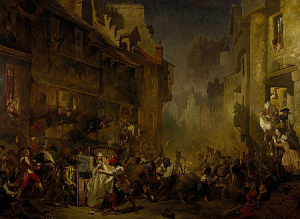 mob, and was tried for murder, and convicted. The Regency reprieved Porteous sentence, preliminary to obtaining a pardon. This outraged the metropolis, who seized the city gates and disarmed the guard. They next opened the jail, took Porteous to his execution, and hanged him over a dyer’s pole. Tytler’s Britannica 231.
mob, and was tried for murder, and convicted. The Regency reprieved Porteous sentence, preliminary to obtaining a pardon. This outraged the metropolis, who seized the city gates and disarmed the guard. They next opened the jail, took Porteous to his execution, and hanged him over a dyer’s pole. Tytler’s Britannica 231.
The Porteous Mob artist James Drummond 1855. The Grassmarket in Edinburgh provides a splendid backdrop for Drummond’s theatrical portrayal of events described in Sir Walter Scott’s novel, the ‘Heart of Midlothian’. Drummond concentrated on one dramatic moment: the lynching of Captain Porteous of the Edinburgh City Guard in 1736. Porteous, however, depicted in red and spreadeagled on the shoulders of his executioners in the middle distance, is of secondary importance in the composition. Precedence is given to a variety of incidents and colourful characters in the foreground. The Royal Association for the Promotion of the Fine Arts in Scotland bought the painting in 1856. www.nationalgalleries.org
 A Lady Descending from a Sedan Chair. Study for the Painting ‘The Porteous Mob’. Artist James Drummond 1855. Drummond made many detailed studies for his great painting showing the execution of Captain Porteous. Although he relegated the main action to the background of the picture, he was careful to ensure that the foreground figures helped to communicate the story as described in Sir Walter Scott’s `Heart of Midlothian?. In the novel, Scott mentions that ladies in sedan chairs were stopped by rioters. Sedan Chairs were common in Edinburgh, as they were able to negotiate the many narrow closes that a carriage could not. The chairs-bearers were normally Highlanders who had moved south in search of work. They were distinguished by their tartan uniforms. In this drawing, Drummond sketched in the sullen face of the stooped chair-bearer, as he peers around the door at his refined passenger. www.nationalgalleries.org
A Lady Descending from a Sedan Chair. Study for the Painting ‘The Porteous Mob’. Artist James Drummond 1855. Drummond made many detailed studies for his great painting showing the execution of Captain Porteous. Although he relegated the main action to the background of the picture, he was careful to ensure that the foreground figures helped to communicate the story as described in Sir Walter Scott’s `Heart of Midlothian?. In the novel, Scott mentions that ladies in sedan chairs were stopped by rioters. Sedan Chairs were common in Edinburgh, as they were able to negotiate the many narrow closes that a carriage could not. The chairs-bearers were normally Highlanders who had moved south in search of work. They were distinguished by their tartan uniforms. In this drawing, Drummond sketched in the sullen face of the stooped chair-bearer, as he peers around the door at his refined passenger. www.nationalgalleries.org
1745 Edinburgh. Noon Chevalier Edward prepares possession of palace of Edinburgh. (TG77-140) Disarming Act effective over evasions. [TG66-233] Edinburgh occupied.
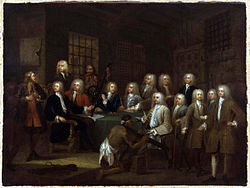 1778 Grant Baronets, of Monymusk, Aberdeen (1705) Sir Archibald Grant, 2nd Baronet, born 25 September 1696, died 17 September 1778, was member of parliament for Aberdeenshire 1722–1732. Grant married four times. By his first wife, Jean, daughter of the Reverend William Meldrum of Meldrum, he had two daughters. His second wife, Anne (died before 1744), daughter of Charles Potts of Castleton in Derbyshire, was the mother of his heir Sir Archibald Grant, 3rd Baronet. The third was Elizabeth (died 1759), widow of James Callander of Jamaica. Finally, Archibald married Jane (1707–1788), widow of Andrew Millar VI, the London Publisher on the Strand, Millar’s (died 8 June 1768), widow Jane, who inherited a life interest in Millar’s estate and the right to dispose directly of L10,000, remarried, becoming Dame Grant of Monymusk in Aberdeenshire and maintaining a coach and horses and a stylish house in Pall Mall until her death at the age of eighty-one. Sir Archibald Grant (standing third from the right) commissioned this painting from William Hogarth.
1778 Grant Baronets, of Monymusk, Aberdeen (1705) Sir Archibald Grant, 2nd Baronet, born 25 September 1696, died 17 September 1778, was member of parliament for Aberdeenshire 1722–1732. Grant married four times. By his first wife, Jean, daughter of the Reverend William Meldrum of Meldrum, he had two daughters. His second wife, Anne (died before 1744), daughter of Charles Potts of Castleton in Derbyshire, was the mother of his heir Sir Archibald Grant, 3rd Baronet. The third was Elizabeth (died 1759), widow of James Callander of Jamaica. Finally, Archibald married Jane (1707–1788), widow of Andrew Millar VI, the London Publisher on the Strand, Millar’s (died 8 June 1768), widow Jane, who inherited a life interest in Millar’s estate and the right to dispose directly of L10,000, remarried, becoming Dame Grant of Monymusk in Aberdeenshire and maintaining a coach and horses and a stylish house in Pall Mall until her death at the age of eighty-one. Sir Archibald Grant (standing third from the right) commissioned this painting from William Hogarth.
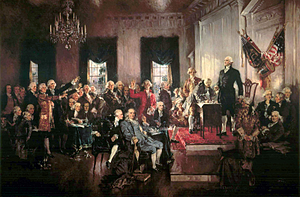 1787 Philadelphia Pennsylvania, Constitutional Convention.
1787 Philadelphia Pennsylvania, Constitutional Convention.
Scene at the Signing of the Constitution of the 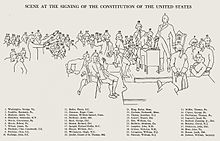 United States, by Howard Chandler Christy
United States, by Howard Chandler Christy
Key to figures in the painting
1814 – Francis Scott Key finishes his poem “Defence of Fort McHenry”, later to be the lyrics of “The Star-Spangled Banner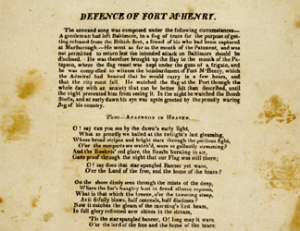
This is the first known printing of Key’s poem. Called a broadside, it was probably printed in Baltimore on Sept. 17, 1814.
amhistory.si.edu
The Fort was named for a Scotsman, The composer was a Scott, as was the attacker Admiral Forester Cochrane (clan Cochrane),
1854 David Dunbar Buick (September 17, 1854 of Arbroath Angus Scotland– March 5, 1929) was a Detroit inventor of the enameled bathtub and the overhead valve engine, best known for founding the Buick Motor Company. He headed this company and its predecessor from 1902 until 1906, thereby helping to create one of the most successful nameplates in United States motor vehicle history.
1862 – The song Riding a Raid, adapted from ‘Bonnie Dundee’ by Scott, takes place during the 1862 Antietam Campaign. J.E.B. Stuart’s Confederate cavalry set off on a screening movement on the flank of Robert E. Lee’s army in order to give Lee time to prepare his army 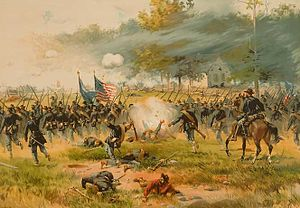 to meet the Union Army after Northern general George B. McClellan had gained information on Lee’s location and plans. The Campaign would culminate in the battle of Antietam, or Sharpsburg, Maryland as the Confederates called it.
to meet the Union Army after Northern general George B. McClellan had gained information on Lee’s location and plans. The Campaign would culminate in the battle of Antietam, or Sharpsburg, Maryland as the Confederates called it.
The Battle of Antietam, by Thure de Thulstrup, depicting the charge of the Iron Brigade near the Dunker Church.
1928 Roderick Andrew Anthony Jude Roddy McDowall (17 September 1928 – 3 October 1998). Board of Governors for the Academy of Motion Pictures Arts and Sciences.
1947 The US Senate advised and consented to the new Secretary of Defense for the National Military Establishment. In other words, the newly organized Department of Defense and Department of the Air Force.
Disclaimer: The author of each article published on this web site owns his or her own words. The opinions, beliefs and viewpoints expressed by the various authors and forum participants on this site do not necessarily reflect the opinions, beliefs and viewpoints of Utah Standard News or official policies of the USN and may actually reflect positions that USN actively opposes. No claim in public domain or fair use. © John Choate.
Utah Standard News depends on the support of readers like you.
Good Journalism requires time, expertise, passion and money. We know you appreciate the coverage here. Please help us to continue as an alternative news website by becoming a subscriber or making a donation. To learn more about our subscription options or make a donation, click here.
To Advertise on UtahStandardNews.com, please contact us at: ed@utahstandardnews.com.



Comments - No Responses to “September 17th Scots Book of Days”
Sure is empty down here...